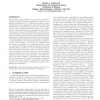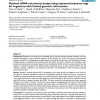831 search results - page 40 / 167 » The many facets of diversity |
PKDD
1999
Springer
13 years 12 months ago
1999
Springer
When mining a large database, the number of patterns discovered can easily exceed the capabilities of a human user to identify interesting results. To address this problem, variou...
IJSI
2008
13 years 7 months ago
2008
Many data mining applications have a large amount of data but labeling data is often difficult, expensive, or time consuming, as it requires human experts for annotation. Semi-supe...
BMCBI
2004
13 years 7 months ago
2004
Background: Expression microarrays are increasingly used to characterize environmental responses and hostparasite interactions for many different organisms. Probe selection for cD...
IROS
2008
IEEE
14 years 2 months ago
2008
IEEE
— Intense efforts to define a common structure in robotic applications, both from a conceptual and from an implementation point of view, have been carried out in the last years ...
ICDM
2005
IEEE
14 years 1 months ago
2005
IEEE
In this work, we introduce the new problem of finding time series discords. Time series discords are subsequences of a longer time series that are maximally different to all the r...


